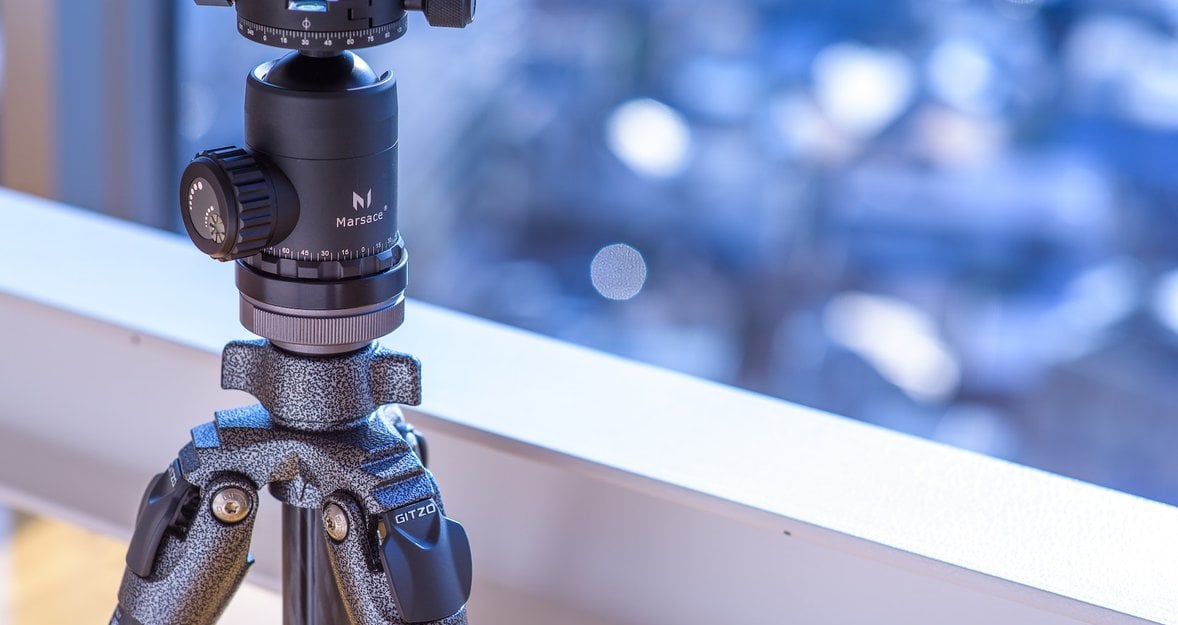Best 10 Tripods for Photography in 2026
Last Updated on January 10, 2025

Both professional and amateur photographers can benefit from a professional tripod in their work. It is a device that allows you to securely fix the camera and avoid uneven and blurry pictures.
When choosing a device, consider its:
- reliability and stability;
- weight and ease of use;
- the price and brand of the device.
These criteria are discussed in detail in this article, and to decide on a suitable tripod you can find the rating of the best models in the price/quality ratio according to 2025. In our camera tripod review, we will show you a list of the best models of 2025.
1. Gitzo Mountaineer
One thing is certain: Gitzo one of the best camera tripods epitomizes quality and craftsmanship. Many professional photographers recognize the convenience and practicality of the entire range of models of this brand. Their attention to detail, exceptional build quality, and unique features make their products one of the best tripods for cameras in the world.
Perhaps the best feature of the Gitzo Mountaineer GT2532 Series 2 besides the overall build quality and compact and lightweight design is the Gitzo G-lock system, which is without a doubt the best locking system for the supports. They look like simple twist locks, but you can lock/unlock all the legs at once or lock/unlock one section without locking the other sections. On other tripods, this will result in endless leg rotation unless you lock the other sections first. This G-lock system is common not only to the Mountaineer series but also to their Traveler and Systematic models. All those features make this model one of the best tripods for photography.
2. Peak Design
Peak Design made from carbon, was first released to the world via Kickstarter, which eventually raised over $12 million. Garnering a lot of attention from users around the world over the years and earn the name of one of the best tripods for DSLR. There may be more online reviews of it than any other particular model. But there are some good reasons for the hype. This model isn't reinventing the wheel — at its core, it's a very well-made, incredibly durable carbon fiber like other best professional tripods. What sets Peak Designs' tripods apart is that they offer several unique features. For example:
- Peak Design supplies a quality padded carrying case (one of the pockets contains a nifty multifunction tool),
- Folding smartphone mount hidden in the center column, and the ability to tighten the lever tripod leg locks.
- For example, Peak Design supplies a quality padded carrying case (one of the pockets contains a nifty multifunction tool), a folding smartphone mount hidden in the center column, and the ability to tighten the lever leg locks. Most noteworthy, however, is the tripod's built-in ball head with a very fancy design, as in a good camera tripod.
The fully integrated ball tripod head is actually part of the center column. If you prefer to use the head of your choice, fear not: the integrated ball head is easy to remove and can be replaced with a universal head adapter. Judging by user reviews, the ball head is phenomenal and in many ways as good as the Arca Swiss. In fact, it has a very similar design. Instead of locking with a knob on the side, as Peak Design it uses a knurled ring around the base of the clamp. This allows you to adjust the best camera stand with both hands and then lock it without even releasing the outer knob. In practice, this is extremely smooth and, most importantly, makes it much easier to frame consistently and accurately.
The only catch with the head is that it has no independent panning function. So, if you're going to do panning, get the Arca Swiss p0 and attach an adapter to it.
3. Gitzo 5
There's nothing to say here that hasn't been addressed above about the Mountaineer - Gitzo's signature features and exceptional build quality remain the same.
The Gitzo Systematics is one of the best camera tripods with more load capacity than anyone could ever need. It has a rated capacity of 40 kg — I have a hard time imagining what kind of system would be too big for this thing. You could probably use it as a bar stool if you didn't have enough room.
The biggest drawback to the Gitzo Systematic Series 5 is, of course, the price tag. These $1,000+ DSLR camera tripods are excessive for most photographers. Not to mention, if you mostly work in the field or travel a lot, you'll almost certainly be better served by a Gitzo Mountaineer or Traveler. But those who require unmatched stability will have a hard time finding a better alternative. If you want the best, this is your choice.
4. Manfrotto
In the more average price range, the Manfrotto MT055CXPro4 is a very good all-around tripod for both studio and fieldwork. When folded down, it's not very small (54 cm) and not particularly light (2 kg), but it's a great compromise between portability and stability, as well as several nice features that make it useful for many studio jobs.
The main feature of the Manfrotto tripod for DSLR cameras is the Q90's center column, which can be rotated 90 degrees to the side, which is a great feature for product photography from above or macro. The Q90 column can also be useful in other ways: it can come in handy for placing light sources overhead or at an angle.
This Q90 column combined with the amazingly low minimum height of only 9 cm makes it a great choice for low-angle and macro photography. You can pretty much orient your camera to fit any situation with this thing. Oh, it also has a bull's-eye bubble level that rotates 360 degrees — you can access it from almost any position.
Manfrotto is probably the most famous name in professional tripods for the camera industry. And with that, they've created a tripod that's incredibly durable and extremely versatile at a reasonable price. Features like the Q90's center column and very low minimum height make it an excellent choice for macro work.
The tripod is covered by a negligible 6-month warranty. However, this can be extended to 10 years if the product is registered. Good or bad, this extra step is common to almost all manufacturers, so be sure to register within the specified time frame, because the 10-year warranty is quite a bargain.
5. Benro Series 2
More often than not, professional photographers recommend carbon fiber tripods for photography—they are much more effective at dissipating vibrations (vibration damping) and settle down much faster than aluminum tripods. They are also lightweight tripods and have better tensile strength, although this is secondary since the main purpose of the tripod is to eliminate camera shakes. However, at the same time, it is better to recommend a very good quality aluminum portable tripod instead of a mediocre carbon fiber tripod. In the budget arena under $200, the Benro TMA28A Series 2 Mach3 takes the crown. At $165.95, it offers all the most important features you look for in a tripod.
With a rated weight capacity of 14 pounds, you can be sure to use just about any DSLR or mirrorless system — keep in mind that the quality of your tripod head often matters a lot more when it comes to heavy rigs. The Benro reaches a decent maximum height of 155 cm, and the center column can be replaced with a short column (included with the tripod) to go down to 32 cm. If you unscrew one of the legs and attach it to the center column, you can have a monopod. Benro's tripod legs can be replaced with metal spikes for use on surfaces such as ice, snow, grass, dirt, or carpet. And there's a hook on the center column if you want to attach counterweights for better stabilization. The tripod is covered by a 3-year limited warranty that can be extended to 5 years upon registration. Not a bad deal for a $165 lightweight tripod for a camera!
6. GorillaPod
JOBY GorillaPod is unusual and is not the first thing to reach for if you're looking for your first tripod.
There are five different versions that you can choose from depending on your needs — all are the same in terms of basic design, but differ in size, length, and carrying capacity. The 325 weighs only 2.2 ounces and is 6.7 inches long.
These models are useful for a variety of purposes. Naturally, they make great tabletop tripods or if you need to position your camera very close to the ground.
The highlight is the GorillaPods legs — they are flexible, so they can be bent and twisted in any direction. This allows the tripod to adapt to uneven surfaces and even wrap around poles, poles, fence rails, etc.
The possibilities are almost limitless, and since the 5K version costs just over $100, there are many reasons why you should consider it for your kit. It won't replace a regular tripod and won't be appropriate in most situations, but in those situations where it is excellent, it will be indispensable.
7. Sachtler
Sachtler is one of the most respected names in the film and video industry. When it comes to top-notch support — their tripods and movable heads are regularly considered some of the best options on the market, especially for those who don't have eight grand to splurge on a Miller or Cartoni system. The company has always been at the forefront of tripod technology, and they partnered with Vinten in 2017 to release the highly revered Sachtler Ace XL with the Flowtech 75 tripod. The vast majority of professional camera tripods have each section of each leg with its own lock — which means you have to unlock, extend the section, lock, and then move on to the next section.
The Flowtech Sachtler uses a single lever at the top to lock/unlock the sections of each leg. The precise design makes the legs slide smoothly out on their own as soon as you unlock them-no need to fumble around and do it yourself. In addition, borrowing the general design from camera tripods, the flowmeter can reach a minimum height of only 10 inches without a mid-level spacer. All you have to do is slide the hinge locking mechanism to switch the legs to the three-stop position. There are other nice little things, too — like magnets that hold folded and stacked legs together, so they don't separate while you're wearing them. Gone are the days of elastic cords to prevent such annoyances. All in all, if you want the best of what's on offer, right down to a cinematic-level tripod combined with an awesome moving head — and you don't want to shell out over $2,000, this is the one for you.
It's worth noting that if you want to buy the Flowtech 75 tripod legs themselves without the Ace XL head, you can do so — they're sold as the Vinten Flowtech 75 Carbon Fiber Tripod. That way you can save some money if you want to choose your own fluid head or already have one. It is no exaggeration to call this model one of the best photography tripods.
8. Manfrotto Nitrotech
The Italian company is one of the favorite photo and video professionals, and it is well known in our country, including an interesting combination of price and quality. Its lineup includes all tripods — from inexpensive amateur, well suited for the phone, and ending with a top-level professional, with a “high six figures” price.
The variant we have chosen is just getting closer to the “psychological boundary” of 6 digits, but let's see what we are offered for that money. The tripod has two aluminum tubes for the upper two sections and two aluminum tubes for the lower sections (something that is lacking in the classic “telescopes”) and it is quite rigid, which is helped by the lower brackets. The tripod is equipped with a 100 mm bowl that allows you to set on it even more serious heads than the one offered in this set (it is designed for a 75 mm bowl and is mounted through an adapter). The maximum load on the tripod is 18 kg and the maximum height is 176 cm. Supported the use of this model in conjunction with video carts such as Manfrotto 114MV Video Dolly.
As for the liquid video head Nitrotech 612, then it is a great solution for cameras up to 12 kg, with a constant counterbalance, adjustable counterweight, and the ability to install accessories when the camera must remain stationary relative to the operator (eg, so installed monitors). Manfrotto holders with “anti-rotation function” and holders with ARRI mounting pins are also supported. Naturally, due to the lower position of the extensions, this tripod is primarily for studio and “official-reporter”, that is, for work in rooms with a normal floor, but not for trips to the countryside or work almost on the fly.
9. Fujimi
And this one of the best tripods for DSLR cameras already has all chances to please the fan of travel: it weighs only 1.5 kg, and thanks to its five-section legs is extremely compact in the folded position — 35 cm! Of course, because of the small diameter of the last sections this construction suffers stiffness in a fully unfolded position, but it will be felt only when using heavy cameras with telephoto lenses, but, say, when shooting panoramas with wide angle lenses on a lightweight mirror-less camera there will be no problems. The camera has a rated load of up to 6 kg and a maximum height of 156 cm.
One of the legs is removable, which turns the tripod into a monopod with a range of heights from 395 to 1145 mm (stem attached directly to the head platform) or 655-1580 mm (the leg is screwed to the column). Standard head with a ball diameter of 36 mm, which is fixed when tightening reliably, but the mechanism for adjusting the resistance is rough: trying to loosen the head a little, you can sharply “drop” the camera on its side. This is typical for inexpensive ball heads, when you work with a heavy camera it makes sense to buy a ball head of the higher class and it does not hurt to have a 3D head in stock too (or a video head if you use your camera for video recording with wireframe as well).
The angle of the legs can only be set in two ways (because the mounts have two-stop protrusions). It is possible to turn the column by 180 degrees. But there are no built-in or removable spikes for the legs, which is strange for a “road” tripod. And even the camouflage color set cover hints at “road”!
10. Falcon Eye
This extremely one of the best cheap tripods for cameras (so you can forgive the plastic molding flaws) is made as a transformer:
- From a table tripod, it turns into an ergonomic handle for a compact camera or smartphone. It has a low carrying capacity of 500 grams and weighs 105 grams.
- The tripod head is tilted and adjustable in only one plane because it is easier to rotate the entire tripod around the vertical axis for such size and weight. The working height of the tripod is 100 mm.
First of all, of course, TablePod is interesting for fans of handheld photography: for a paltry sum, it will allow you to hold a miniature camera or smartphone more conveniently. The main thing is that the gadget itself has at least a digital stabilizer. And if necessary, it will always be possible to set the camera on a table or shelf.
Conclusion
Let's start with the conditions under which you are going to use the professional tripod for the camera. If you are interested in maximum rigid fixation and vibration damping, then the model made of carbon is the best, if you are going to use it for camping and portability and lightweight is extremely important, then the aluminum model is undoubtedly the best.
An important element of a tripod is its head. It also determines the peculiarities of the tripod application. In general, we can make this division:
- 2D heads allow only to rotate off the camera or tilt it back and forth, it is impossible to turn it sideways – that's why they are also called "video heads", the camera is better to have the possibility to rotate 90 degrees for vertical orientation of photos.
- Accordingly, such a head will already be called 3D: it introduces an additional hinge to adjust the camera tilt sideways. The basic feature of both 2D and 3D is the separate fixation of each axis: by moving the camera along one axis you can leave the rest rigidly fixed.
- Ball heads, on the other hand, allow you to move the camera on all axes simultaneously and have a single lock for all axes.
Regardless of the type of head, the tripod must have sufficient rigidity. Otherwise, the slightest touch will already cause shaking in the viewfinder, especially when using long-focus optics. And of course, fixings have to withstand the weight of the camera – pay attention to the maximum safe weight of the equipment you are mounting in the specifications. A good rule of thumb is to divide this figure in half, and when working with heavy telephoto lenses give even more margin. And don't forget that for cheap tripods this figure may be stated "too optimistically" by the manufacturer.





